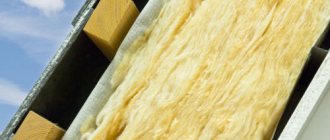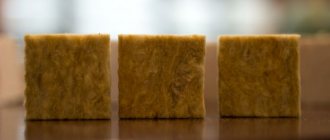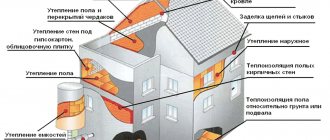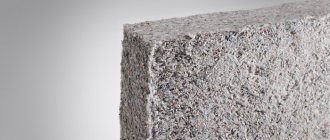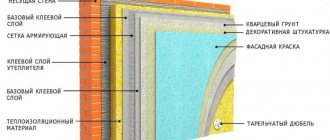Roll and slab insulation materials are used today in almost all areas of construction - from residential to industrial. Among the most popular and inexpensive solutions is mineral wool, the health hazards of which are sometimes the reason that people prefer to live in less comfortable temperature conditions. But is the widely used insulation really that dangerous and is it worth limiting yourself in comfort for fear of harming your own health?
Mineral wool - should you be afraid of it?
What does mineral wool consist of?
Many say that mineral wool causes serious harm to health. How true this statement is can only be said after studying the composition of the material. It consists of several components:
- base obtained by melting rock fibers;
- binder resins capable of forming the required shape of the material - roll or slab;
- impregnations that make mineral wool impervious to external influences.
Glass wool, which is based on a mixture of broken glass, limestone, and quartz glass, also belongs to the category of mineral wool. The mixture is melted and inflated with steam to obtain the finest air threads, which allows the insulation to recover after compression.
The material has a number of advantages that make it one of the industry leaders, namely:
- low thermal conductivity - from 0.035 to 0.042 W/mK;
- reduced moisture saturation coefficient (up to 1%);
- no shrinkage during long-term use;
- durability.
The stone base is environmentally friendly and does not have any harmful effects on the human body. Resins and impregnations, if the manufacturing and installation technology is not followed, can negatively affect health, but how serious will this impact be?
How does mineral wool affect the health of household members and insulation workers?
What is the material
To figure out whether stone wool is harmful to human health, let's figure out what it is and what it is made of. So, the material includes the following components:
- Fibers (the basis of insulation). Obtained by melting rocks. Most often, basalt is used for these purposes - an absolutely safe raw material, which is used even in medicine. True, sometimes cotton wool is made from melted blast furnace slag. But, recently it is very rare to find this insulation on sale;
- Binder. Manufacturers form slabs or rolls from mineral fibers. To ensure a stable form of thermal insulation, the fibers are glued together using resin;
- Impregnations. To improve certain qualities of the material, it is treated with all kinds of compounds.
The photo shows the structure of stone wool
Thus, this insulation has a fibrous structure. Most of the volume is occupied by air and fibers obtained from natural materials.
Myth No. 1. Toxic substances in the environment
Excellent thermal insulation, excellent sound insulation properties, effective fire protection. Such attractive properties make mineral wool popular. But today it is customary to care not only about the comfort of household members, but also about the environment in general. Every conscious person thinks about the impact the material used when building a house or renovating an apartment will have on the environment.
The binders in mineral wool are phenolic resins, which can release toxic substances. Phenol when ingested:
- affects the brain, provoking short-term excitement and subsequent loss of strength;
- provokes headaches;
- causes coughing and other problems in the respiratory system, including respiratory arrest;
- promotes attacks of nausea and vomiting;
- leads to convulsions, fainting, damage to the cornea of the eyes, surges in blood pressure;
- causes the growth of malignant tumors;
- may cause the birth of children with mental or physical retardation.
But the mass fraction of phenol in the material is so small (1-2%) that in order to cause damage to health, you need to try hard. However, manufacturers take into account the opinions of their customers who fear that the material is harmful. Poisonous binders are not only contained in cotton wool in negligible quantities, but also remain in a polymerized state, which does not pose a danger to human health. Today they have begun to produce mineral wool, which instead of phenol contains completely safe and environmentally friendly bitumen.
The second thing that opponents of using mineral wool for insulation are afraid of is formaldehyde, the permissible concentration of which per 1 cubic meter should not exceed 0.05 mg. Low-quality materials can produce up to 0.02 mg of formaldehyde per square meter of insulated surface per hour. In addition, this poison is released by many finishing materials and furniture. This can lead to oversaturation of the air with poison, which can lead to irreversible damage to the human body, for example, causing infertility.
“Phenol-free” mineral wool from Knauf
Leading companies producing mineral wool
Thanks to its high-quality, versatile products, Rockwool stone wool has become so widely used. There are many more companies that also supply their insulation materials to the CIS countries. Among them are the most famous and popular:
- "TechnoNIKOL".
- Turkart.
- Nobasil.
- PAROC.
These companies are preferred by Russian builders. All these companies have an extensive range, where one type of insulation may be better than another, and vice versa. There is competition among manufacturers, so you shouldn’t take everything from one organization. It is better to explore construction forums where people share their experiences. After all, stone wool is always selected, the reviews of which are the most positive for a certain type of work. Nowadays, the insulation of buildings is so diverse in scope and implementation that the material should be chosen for a specific, narrowly focused work.
Another popular stone wool among craftsmen is TechnoNIKOL. It is used by both professionals and home craftsmen. There is also a wide range of not only stone, but also glass wool, and other materials for insulation. Their products can be found both in construction stores and in the online store. However, you should always remember the harm this material can cause to health, so you should always install it correctly so that dust and fumes cannot escape. This applies to any insulating materials, regardless of whether it is TechnoNIKOL stone wool or another.
Myth No. 2. Harm from contact with water
Perhaps the myth about the dangers of contact of mineral wool with water is the most justified. But this applies to a material that is produced using outdated technology - glass wool. A negative reaction of insulation to direct contact with water or wet steam leads to the accumulation of liquid, the subsequent formation of fungus and destructive mold.
And it is mold that harms humans, depressing the immune system, causing allergies, inflammatory processes in the respiratory system, skin diseases, cardiovascular pathologies, and damage to the central nervous system.
Advice! A competent approach to the choice of material will allow you to avoid the effects of mold on the body. That is, when purchasing insulation, you should give preference to a product with the lowest water absorption coefficient. In this case, even at high humidity, mineral wool will not absorb moisture and gradually transform it into mold.
High-quality wool is used to insulate facades that are not protected from moisture.
Myth No. 3. Damage from fire of mineral wool
The most ridiculous myth about mineral wool is the high probability of the material igniting upon contact with fire. The absurdity of this assumption is obvious, because the basis of mineral wool is fibers obtained from stone. And, as you know, it is impossible to burn a stone. You cannot burn its derivatives either.
Of course, if you direct the flame of a gas burner at a layer of insulation, it will not withstand the force of the fire. But it won’t catch fire, it will simply char and turn black. There is no further spread of fire, the mineral wool does not smolder and does not release harmful substances into the air. The material is fire-resistant and can be used in facilities with a high fire hazard.
Mineral wool is a material that, in the event of a fire, will not allow the fire to spread to other rooms and buildings
Myth No. 4. Dust release in the house
The myth about dust, which can penetrate the lungs and cause a number of health problems, is associated with its predecessor - glass wool, widely used in Soviet times in the absence of alternative solutions for insulating buildings, communications and structures. Many still prefer this type of insulation today. The glass contained in such material is indeed capable of crumbling under mechanical stress. Glass dust settles in the lungs and on the skin, causing eye injuries, etc.
Modern insulation does not have such shortcomings. The material does not crumble during use, and the dust formed in its pores is no different from ordinary household dust. Considering that the insulation is covered with a layer of finishing, the amount of dust generated in a closed space is sharply limited and does not pose a health hazard. High-quality insulation will make the release of dust into the air almost impossible.
For more information about the dust emitted by mineral wool and its possible health hazards, watch the video:
What is the safest insulation
Ursa PureOne - formaldehyde-free, acrylic based.
There is no point in determining which insulation is safe for health among natural materials, so only modern insulation of artificial origin should be considered. The most used thermal insulation materials:
- mineral wool;
- Styrofoam;
- polyurethane foam.
Typically, the manufacturers of each of the materials presented above claim that their insulation is safe for health. In fact, this is true, and disputes regarding the safety of a particular material revolve mainly around the components from which the insulation is made. It is also important how the insulation behaves under different operating conditions. For example, polystyrene foam is harmful as insulation if it is heated. During the process of melting or burning, it emits toxic gases, just like polyurethane foam. PPU is nothing more than a modified polystyrene foam, its improved descendant, so to speak.
If we consider the components of which insulation are absolutely safe for health, then you cannot find better mineral wool from Ursa from the PureOne line:
- made from quartz sand;
- does not contain formaldehyde - acrylic-based binder;
- soft fibers that do not break or create dust;
- does not irritate the skin - the color and texture is similar to cotton.
In addition, this material does not burn and can withstand temperatures above 800 degrees, which significantly expands the scope of its application.
Is mineral wool harmful to health or not?
Mineral wool is one of the materials that has both ardent opponents and supporters who claim that this is the best way to quickly and efficiently insulate a house. Most often, a negative opinion is generated by rumors or the example of friends who have chosen low-quality material. Well-known manufacturers take into account that today, when choosing insulation, the buyer’s attention is paid not only to the thermal insulation qualities and cost of the product, but also to environmental friendliness, non-flammability, vapor and moisture permeability.

